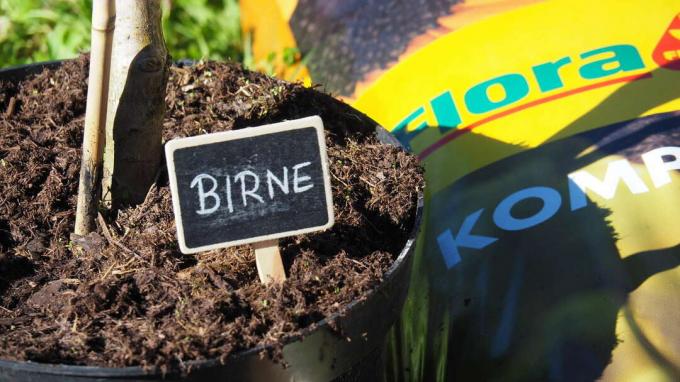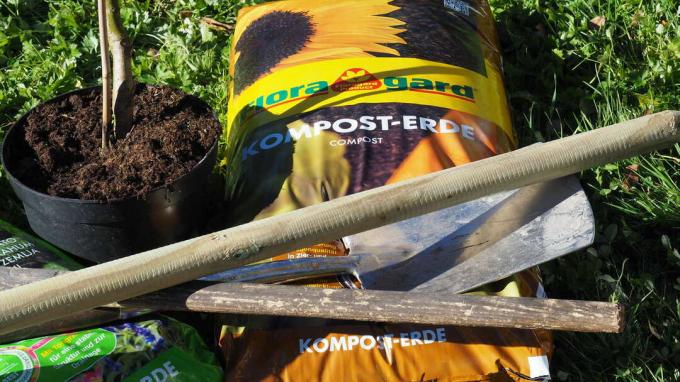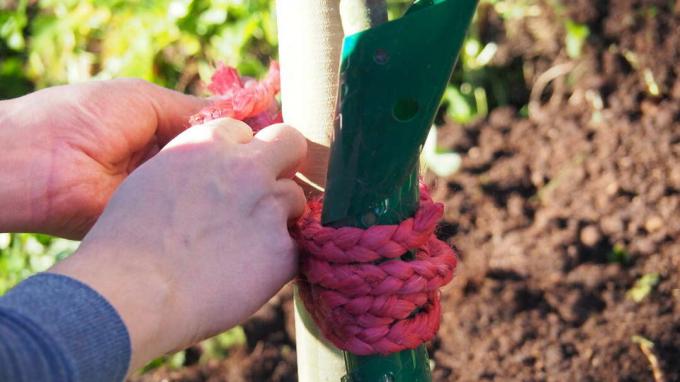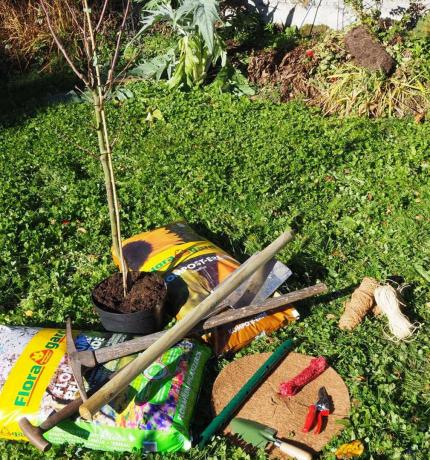You can't compare apples with oranges. That is why we explain in our instructions what you have to pay particular attention to when planting pear trees.
The pear (Pyrus), for some the big little sister of the apple, was already worshiped as a sacred tree by the Babylonians. It is planted both as a cultivated fruit and as an ornament in large parts of Europe. Although there are many different types that are suitable for consumption, only a few are commercially available. In order to benefit from the variety of this plant, you should definitely plant pear trees in your own garden.
contents
- Buying a pear tree: as a pot or a ball?
- Planting a pear tree: the right planting time
-
Instructions for planting pear trees
- Materials needed to plant a pear tree
- Choose a suitable location for the pear tree
- Dig the planting hole for the pear tree
- Attach support post for pear tree
- Prepare the planting hole for the pear tree
- Prepare the pear tree before planting
- Plant the pear tree
- Care for the pear tree after planting
Buying a pear tree: as a pot or a ball?
It is best to find out about suitable varieties that are adapted to the local conditions in your garden at a nursery of your choice. Usually one and the same variety is even offered as bale goods and as container goods. But what is the difference?

The answer to this question lies in the type of cultivation. Trees that are sold as bales are in the field and are only gouged out with a ball of earth and packed before ordering. As a rule, these trees grow well with proper planting, as only a small part of the root mass is lost when transplanted. However, they are only available in this form in early spring or autumn. In contrast, container goods are available all year round, but the trees are usually not quite as robust, because the cultivation takes place in a container (or tub) in which it is later sold will. A great advantage of container goods, however, is that no root mass is lost through the pruning and the tree therefore develops very well in the first year. An overview of the best and most popular Pear varieties You will find here.
Planting a pear tree: the right planting time
Like all other fruit trees, pear trees are best planted in autumn (October / November). In this way, the trees can grow well over the winter and spread their roots. Alternatively, spring planting is also possible from March when no more severe frosts are to be expected. At this time, the so-called bale goods are also available in many tree nurseries.

Instructions for planting pear trees
The best way to go about planting a new pear tree is step by step. We have prepared detailed instructions for you below.
Materials needed to plant a pear tree
The following utensils should be ready for planting a pear tree:
- Spade, shovel, hoe
- Support pile, binding material
- Hammer, secateurs
- Fresh potting soil and compost
- Trunk protection, coconut mat

Choose a suitable location for the pear tree
So that your pear tree can grow and thrive well, the choice of location is of great importance. Pears prefer a sunny, warm and sheltered location. For example, a place on a sunny house wall, where it can also be used as a trellis tree, is ideal. Most suitable for pear trees are sandy loam soils with a sufficient amount of humus. Sandy, poor soils can be upgraded with compost or rotted manure, for example.
Dig the planting hole for the pear tree
First you need to estimate the size of the planting hole. The following rule applies: the planting hole should be about twice as large as the pot and about a third deeper than the height of the root ball of the tree. Use the spade to roughly pierce the outline of the planting hole and then remove the individual layers of soil. Then the soil at the bottom of the hole is loosened well with a hoe.

tip: Grafted pear trees can vary in size depending on the rootstock used. When planting, make sure that there is sufficient distance from other trees so that the full-grown pear tree still has enough space. In fact, it is also possible to graft a pear onto a quince. Both species belong to the Rosaceae family. An intergrowth of plants from different genera is an exception, so not all genera of the rose family can grow together stably. The connection of the Pear variety 'Conference' with a quince, for example, is not entirely stable. For better compatibility, an intermediate refinement with ‘Gellert's Butter Pear‘Recommended, which combines better with the quince pad. Incidentally, it is precisely the not quite perfect intergrowth that has the effect that the assembled tree grows weaker and remains smaller. Quince rootstocks were bred for pears because for a long time there were no weak-growing pears available for them.
Attach support post for pear tree
If the planting hole has already been dug, a support pole can be driven in straight away. The pear tree will later be tied to this. The post should be about the same height as the trunk. The west side of the planting hole is particularly suitable for this, as the tree will later be pushed away from the post by the wind.
Prepare the planting hole for the pear tree
In order to provide the pear tree with good starting conditions, it is best to put some fresh potting soil and some compost soil in the planting hole. Then mix the different layers well and, if necessary, add some fertilizer with an organic long-term effect in granulate form - such as ours Plantura organic tomato fertilizer - a. This is gradually broken down by the microorganisms in the soil and releases the nutrients for the plant.
Prepare the pear tree before planting
Next, score a little all around the root ball with scissors and loosen it up with your hands. The small injuries create new roots that grow downwards and can suck in water very well. As a rule, container goods do not have to be cut back.
Tip from the professional: If the root ball is very dry after buying it, it can be dipped into a bucket of water again before being inserted.
Plant the pear tree
Place the young pear tree in the planting hole so that the grafting point protrudes at least 5 centimeters above ground level. Then fill the hole with the excavated earth again and carefully step on it so that all cavities are closed. Finally, you should water the newly planted tree well. Sludging ensures that the soil settles well in the planting hole and surrounds the roots.

In order to protect the pear tree from strong winds, it is now tied a hand's breadth below the end of the post. You should be careful not to attach the rope too tightly so that the tree does not suffer from constrictions. Attaching a special feed guard also protects the young tree from rodents. Placing a coconut mat underneath ensures that the tree slice remains free of weeds and that there is no competition for nutrients between the herbs and the shallow-rooted pear tree.

Planting a pear tree summary:
- Autumn planting (October / November) is ideal
- Prefers a sunny, sheltered location
- The planting hole should be at least twice as large as the pot
- Drive in the support post on the west side
- Bring in fresh potting soil and compost
- Slightly scratch the root ball and loosen it
- Place the tree in the middle and close the hole with the excavated earth
- Step up carefully and sludge well
- Tie to a stake, attach anti-seizure protection and place a coconut mat on the ground

Care for the pear tree after planting
Young fruit trees in particular should always be supplied with sufficient water in the first few years after they have been planted. With annual fertilization with compost or organic long-term fertilizers you also optimally support the growth and development of your tree so that you can harvest the first pears soon. For a rich harvest, however, the correct training pruning and later the regular clearing pruning are also important. More information about the Pruning pear trees can be found in our special article.
